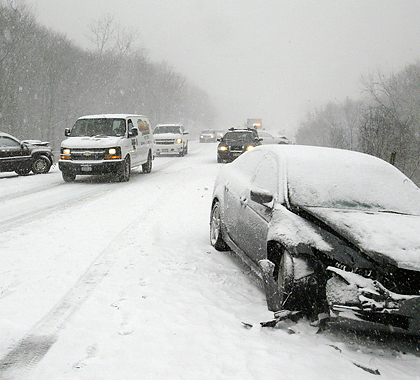As a polar vortex held much of the nation in its icy grip, with record-low temperatures recorded in many locations, President Donald Trump ridiculed global warming alarmism.
Trump tweeted, “In the beautiful Midwest, windchill temperatures are reaching minus 60 degrees, the coldest ever recorded. In coming days, expected to get even colder. People can’t last outside even for minutes. What the hell is going on with Global Warming? Please come back fast, we need you!”
Obama-era holdovers at the National Oceanic and Atmospheric Administration (NOAA) immediately tweeted in response, “Winter storms don’t prove that global warming isn’t happening.”
The mainstream media parroted NOAA’s response, noting no single cold spell or winter storm is proof humans aren’t causing global warming.
Weather Is Not Climate
It’s certainly true there is a difference between weather and climate. However, climate alarmists and their lapdogs in the mainstream media somehow fail to remember this fact every year when they breathlessly claim a single flood or hurricane, a busy hurricane season, or a large wildfire shows humans are causing dangerous climate change. Guess what? Those events are just weather too.
A region’s climate is its geology, topography, and weather patterns and history measured and/or averaged over long periods of time. We have had record-setting polar vortex events three of the last five years. Could it be a trend?
The way to find out is to look at potential causes. NASA recently noted record-low sunspot activity could portend an extended period of below-average temperatures. As reported in the American Thinker, “Martin Mlynczak of NASA’s Langley Research Center reported in September: ‘High above Earth’s surface, near the edge of space, our atmosphere is losing heat energy. If current trends continue, it could soon set a Space Age record for cold.'”
Contradictory Climate Claims
Although winter storms don’t prove global warming isn’t happening, they do contradict predictions made by many of the same climate change charlatans just a few years ago that human-caused climate change would make snow nonexistent, or nearly so, in the near future.
In February 2014, The New York Times ran an article titled “The End of Snow.” Less than a month later, the U.S. East Coast got pounded with record cold and snow. Some of those records were broken during a 2017 cold spell, and new snow records are being set across the United States, including in Hawaii, this year.
A 2014 Daily Caller article reported that in 2000, scientists in the U.K. said global warming would make snowfall a rare event, quoting one as saying, “Children just aren’t going to know what snow is.” Since then, several regions in the U.K. have experienced multiple seasons of deep snow and record-setting cold, as have many other places across Europe, Russia, and China.
Concerning hurricanes, the media uncritically reported claims made by some scientists the busy 2017 Atlantic hurricane season was consistent with climate model projections of more powerful hurricanes. Those stories failed to note that before the 2017 season, the United States had gone through the longest period in recorded history—more than 14 years—without a Class 3 or higher hurricane making landfall. That 14-year hurricane hiatus was completely inconsistent with climate model projections.
Climate Religion, Not Science
I have come to the conclusion the hypothesis of human-caused climate change is really more akin to a religious belief—a revealed truth about human sins (fossil-fuel use) and their consequences (all manner of calamities)—rather than a testable scientific theory.
Albert Einstein once said, “No amount of experimentation can ever prove me right; a single experiment can prove me wrong.” Einstein’s words express a foundational principle of science identified by the philosopher Karl Popper: falsifiability. For a claim to be scientific, there must be conditions which could prove it false. A thousand observations may appear to verify a hypothesis, but one critical failure could result in its demise. The history of science is littered with such examples.
The current hypothesis on anthropogenic climate change should be no exception to this principle, but it is.
No matter what the climate phenomenon, if climate alarmists can present it as being unusual, they claim it is “evidence humans are causing climate change,” even if it contradicts earlier phenomena the same people pointed to as evidence of anthropogenic climate change.
In climate change research, different models looking at the same phenomenon applying the same laws of physics with the same inputs produce dramatically varied results. One model says we can expect the polar ice sheets to melt, raising sea levels, while another predicts the coming of the next ice age, causing sea levels to fall sharply. One model will forecast long-term drought in the Southwest, whereas another model predicts increased precipitation. How does one test or disprove a theory that is predicted to cause both an increase and a decrease in the water levels of the Great Lakes?
‘Shut Up,’ They Explained
When confronted with facts casting doubt on aspects of the theory of human-caused climate change, climate alarmists revert to ad hominem attacks, calling the researchers providing such evidence insulting names or questioning their motives instead of addressing the substance of their arguments.
This response is a hallmark of doctrinaire religious zealots, not of scientists engaged in an honest exchange of ideas in pursuit of knowledge.
H. Sterling Burnett, Ph.D. ([email protected]) is a senior fellow on energy and the environment at The Heartland Institute, a nonpartisan, nonprofit research center headquartered in Arlington Heights, Illinois. An earlier version of this article was published in the Madison St. Clair Record. Used with permission.





